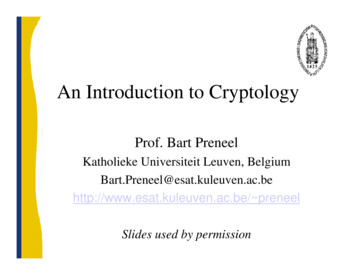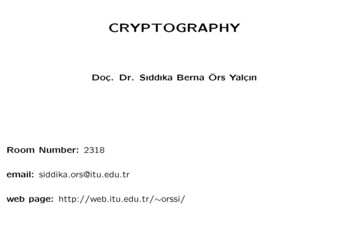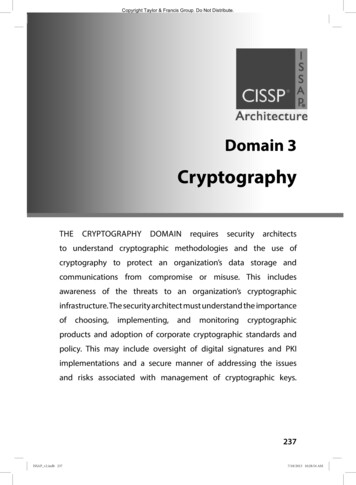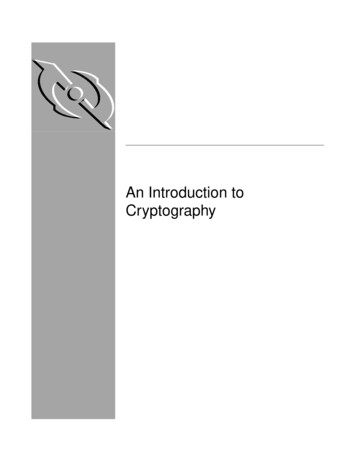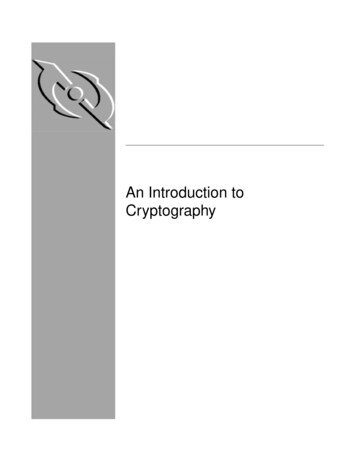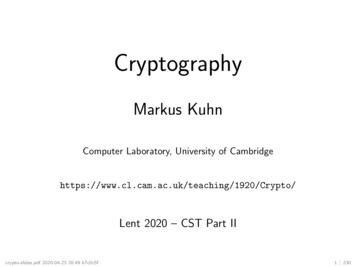
Transcription
cryptography#cryptography
Table of ContentsAbout1Chapter 1: Getting started with cryptography2Remarks2Examples2Integrity Validated - Symmetric Key - Encryption and Decryption example using Java2Introduction8Chapter 2: Caesar on implementation10The ASCII way10ROT1310A Java implementation for Caesar Cipher11Python implementation13Chapter 3: Playfair Cipher17Introduction17Examples17Example of Playfair Cipher Encryption along with Encryption and Decryption RuleCredits1722
AboutYou can share this PDF with anyone you feel could benefit from it, downloaded the latest versionfrom: cryptographyIt is an unofficial and free cryptography ebook created for educational purposes. All the content isextracted from Stack Overflow Documentation, which is written by many hardworking individuals atStack Overflow. It is neither affiliated with Stack Overflow nor official cryptography.The content is released under Creative Commons BY-SA, and the list of contributors to eachchapter are provided in the credits section at the end of this book. Images may be copyright oftheir respective owners unless otherwise specified. All trademarks and registered trademarks arethe property of their respective company owners.Use the content presented in this book at your own risk; it is not guaranteed to be correct noraccurate, please send your feedback and corrections to info@zzzprojects.comhttps://riptutorial.com/1
Chapter 1: Getting started with cryptographyRemarksModern cryptography is the cornerstone of computer and communications security. Its foundationis based on concepts of mathematics such as number theory, computational-complexity theory,and probability theory.Cryptography deals with the securing of digital data. It refers to the design of mechanisms basedon mathematical algorithms. The primary objective of using cryptography is to provide the fourfundamental information security services; confidentiality, non-repudiation, authentication anddata-integrity.ExamplesIntegrity Validated - Symmetric Key - Encryption and Decryption exampleusing JavaEncryption is used to transform data in its orignal format (Eg: The contents of a letter, Credentialspart of authorizing a financial transaction) to something that cannot be easily reconstructed byanyone who is not intended to be part of the conversation.Basically encryption is used to prevent eavesdropping between any two entities (individuals or agroup).In case of symmetric encryption, both the sender and receiver (Eg: Alice, Bob) must use the sameencryption algorithm (generally a standardised one) and the same encryption key (known only tothe two of de/security/jce/JCERefGuide.html#ExamplesRelated Links https://en.wikipedia.org/wiki/History of cryptography https://en.wikipedia.org/wiki/Cryptographypackage thmParameterSpec;java.util.StringTokenizer;import javax.crypto.BadPaddingException;import javax.crypto.Cipher;import tutorial.com/2
etKeySpec;javax.xml.bind.DatatypeConverter;/**** p Encryption is used to transform data in its orignal format (Eg: The contents of aletter, Credentials part of authorizing a financial transaction) to something that* cannot be easily reconstructed by anyone who is not intended to be part of theconversation. /p * p Basically encryption is used to prevent eavesdropping between any two entities* (individuals or a group). /p ** p In case of symmetric encryption, both the sender and receiver (Eg: Alice, Bob) must usethe same encryption algorithm (generally a standardised one)* and the same encryption key (known only to the two of them). /p ** p urity/jce/JCERefGuide.html#Examples /p ** p Related Links /p * ul * li https://en.wikipedia.org/wiki/History of cryptography /li * li https://en.wikipedia.org/wiki/Cryptography /li * /ul ** pre *ChangeLog : 2016-09-24*1. The modified encrypted text is now reflected correctly in the log and alsoupdated same in javadoc comment.* /pre * @author Ravindra HV (with inputs w.r.t integrity check /artjom-b])* @since (30 July 2016)* @version 0.3**/public class IntegrityValidatedSymmetricCipherExample {/*** p https://en.wikipedia.org/wiki/Advanced Encryption Standard /p */private static final String SYMMETRIC ENCRYPTION ALGORITHM NAME "AES"; // The currentstandard encryption algorithm (as of writing)/*** p Higher the number, the better /p * p Encryption is performed on chunks of data defined by the key size /p * p Higher key sizes may require modification to the JDK (Unlimited StrengthCryptography) /p **/private static final int SYMMETRIC ENCRYPTION KEY SIZE 128; // lengths can be 128, 192and 256/**https://riptutorial.com/3
* p ** /p * p A transformation defines in what manner the encryption should be performed.Eg: Whether there is any link between two chunks of encrypted data (CBC) or whatshould happen*if there is a mismatch between the key-size and the data length.** /p ** p https://en.wikipedia.org/wiki/Block cipher mode of operation /p */private static final String SYMMETRIC ENCRYPTION TRANSFORMATION "AES/CBC/PKCS5Padding";private static final Charset CHARSET INSTANCE UTF8 Charset.forName("UTF-8");private static final int AES IV KEY SIZE 128; // for AES, iv key size is fixed at 128independent of key-sizeprivate static final String MAC ALGORITHM NAME HMAC SHA256 "HmacSHA256";private static final String HASH FIELDS SEPARATOR " " ;/*** @param args* p Sample output. /p * pre Encrypted, Base64 encoded text:W1DePjeYMlI6xmyq9jr cw 55F80F4C2987CC143C69563025FACE22 GLR3T8GdcocpsTM1qSXp5jLsNx6QRK880BtgnV1jFg0 Decrypted text :helloworldEncrypted, Base64 encoded text v2:1XX/A9BO1Cp8mK SHh9iHA B8294AC9967BB57D714ACCB3EE5710BD TnjdaWbvp H6yCbAAQFMkWNixeW8VwmW48YlKA/AAyDecrypted text - v2:helloworldEncrypted, Base64 encoded text - v3(original):EU4 rAZ2vOKtoSDiDPcO A AEEB8DD341D8D9CD2EDFA05A4595EBD2 7anESSSJf1dHobS5tDdQ1mCNkFcIgCvtNCEncrypted, Base64 encoded text - v3(modified):FU4 rAZ2vOKtoSDiDPcO A AEEB8DD341D8D9CD2EDFA05A4595EBD2 7anESSSJf1dHobS5tDdQ1mCNkFcIgCvtNCError : Integrity check failedException in thread "main" java.lang.RuntimeException: Error : Integrity check .main(IntegrityV* /pre */public static void main(String[] args) {/** EncryptionKey : Shared secret between receiver and sender (who generates thepassword and how its shared depends on the purpose)* This program generates a new one every time its run !* Normally it would be generated once and then be stored somewhere (Eg: In a JCEKSkeystore file).*/https://riptutorial.com/4
byte[] generatedSharedSecret secretKeyGeneratorUtility();byte[] generatedSharedHMACKey secretKeyGeneratorUtility();String plainText "helloworld";String encryptedText encrypt(plainText, em.out.println("Encrypted, Base64 encoded text :" encryptedText);String decryptedText decrypt(encryptedText, em.out.println("Decrypted text :" decryptedText);String encryptedTextTwo encrypt(plainText, em.out.println("Encrypted, Base64 encoded text - v2:" encryptedTextTwo);String decryptedTextTwo decrypt(encryptedTextTwo, em.out.println("Decrypted text - v2:" decryptedTextTwo);String encryptedTextThree encrypt(plainText, em.out.println("Encrypted, Base64 encoded text - v3(original):" encryptedTextThree);char[] encryptedTextThreeChars eChars[0] (char) ((encryptedTextThreeChars[0]) 1);String encryptedTextThreeModified new ("Encrypted, Base64 encoded text - v3(modified):" encryptedTextThreeModified);String decryptedTextThree decrypt(encryptedTextThreeModified, em.out.println("Decrypted text - v3:" decryptedTextThree);}public static String encrypt(String plainText, byte[] key, byte[] hmacKey) {byte[] plainDataBytes plainText.getBytes(CHARSET INSTANCE UTF8);byte[] iv initializationVectorGeneratorUtility();byte[] encryptedDataBytes encrypt(plainDataBytes, key, iv);String initializationVectorHex DatatypeConverter.printHexBinary(iv);String encryptedBase64EncodedString ytes); // Generally the encrypted data isencoded in Base64 or hexadecimal encoding for ease of handling.String hashInputString encryptedBase64EncodedString HASH FIELDS SEPARATOR initializationVectorHex HASH FIELDS SEPARATOR;String hashedOutputString hKey(hmacKey,hashInputString.getBytes(CHARSET INSTANCE UTF8)));String encryptionResult hashInputString hashedOutputString;return encryptionResult;}public static byte[] encrypt(byte[] plainDataBytes, byte[] key, byte[] iv) {byte[] encryptedDataBytes encryptOrDecrypt(plainDataBytes, key, iv, true);return encryptedDataBytes;}public static String decrypt(String cipherInput, byte[] key, byte[] hmacKey) {https://riptutorial.com/5
StringTokenizer stringTokenizer new StringTokenizer(cipherInput,HASH FIELDS SEPARATOR);String encryptedString stringTokenizer.nextToken();String initializationVectorHex stringTokenizer.nextToken();String hashedString stringTokenizer.nextToken();String hashInputString encryptedString HASH FIELDS SEPARATOR initializationVectorHex HASH FIELDS SEPARATOR;String hashedOutputString hKey(hmacKey,hashInputString.getBytes(CHARSET INSTANCE UTF8)));if( hashedString.equals(hashedOutputString) false ) {String message "Error : Integrity check failed";System.out.println(message);throw new RuntimeException(message);}byte[] encryptedDataBytes g); //The Base64 encoding must be reversed so as to reconstruct the raw bytes.byte[] iv torHex);byte[] plainDataBytes decrypt(encryptedDataBytes, key, iv);String plainText new String(plainDataBytes, CHARSET INSTANCE UTF8);return plainText;}public static byte[] decrypt(byte[] encryptedDataBytes, byte[] key, byte[] iv) {byte[] decryptedDataBytes encryptOrDecrypt(encryptedDataBytes, key, iv, false);return decryptedDataBytes;}public static byte[] encryptOrDecrypt(byte[] inputDataBytes, byte[] key, byte[] iv,boolean encrypt) {byte[] resultDataBytes null;// Exceptions, if any, are just logged to console for this example.try {Cipher cipher Cipher.getInstance(SYMMETRIC ENCRYPTION TRANSFORMATION);SecretKey secretKey new SecretKeySpec(key, SYMMETRIC ENCRYPTION ALGORITHM NAME);AlgorithmParameterSpec algorithmParameterSpec new IvParameterSpec(iv);if(encrypt) {cipher.init(Cipher.ENCRYPT MODE, secretKey, algorithmParameterSpec);}else {cipher.init(Cipher.DECRYPT MODE, secretKey, algorithmParameterSpec);}resultDataBytes cipher.doFinal(inputDataBytes); // In relative terms, invokingdo-final in one go is fine as long as the input size is small.} catch (NoSuchAlgorithmException e) {e.printStackTrace();} catch (NoSuchPaddingException e) {e.printStackTrace();} catch (InvalidKeyException e) {e.printStackTrace();} catch (IllegalBlockSizeException e) {e.printStackTrace();} catch (BadPaddingException e) {e.printStackTrace();https://riptutorial.com/6
} catch (InvalidAlgorithmParameterException e) {e.printStackTrace();}return resultDataBytes;}private static byte[] secretKeyGeneratorUtility() {byte[] keyBytes null;try {KeyGenerator keyGenerator KeyGenerator.getInstance(SYMMETRIC ENCRYPTION ALGORITHM NAME);keyGenerator.init(SYMMETRIC ENCRYPTION KEY SIZE);SecretKey secretKey keyGenerator.generateKey();keyBytes secretKey.getEncoded();} catch (NoSuchAlgorithmException e) {e.printStackTrace();}return keyBytes;}/*** p InitialVector : Helps in avoiding generating the same encrypted result, even whenthe same encryption - algorithm and key are used. /p * p Since this is also required to be known to both sender and receiver, its eitherbased on some convention or is part of the cipher-text transmitted. /p * p https://en.wikipedia.org/wiki/Initialization vector /p * @return*/private static byte[] initializationVectorGeneratorUtility() {byte[] initialVectorResult null;try {KeyGenerator keyGenerator KeyGenerator.getInstance(SYMMETRIC ENCRYPTION ALGORITHM NAME);keyGenerator.init(AES IV KEY SIZE);SecretKey secretKey keyGenerator.generateKey();initialVectorResult secretKey.getEncoded();} catch (NoSuchAlgorithmException e) {e.printStackTrace();}return initialVectorResult;}private static byte[] messageHashWithKey(byte[] key, byte[] data) { // byte[] iv,byte[] hmac null;try {Mac mac Mac.getInstance(MAC ALGORITHM NAME HMAC SHA256);SecretKeySpec secretKeySpec new SecretKeySpec(key,MAC ALGORITHM NAME HMAC SHA256);//AlgorithmParameterSpec algorithmParameterSpec new IvParameterSpec(iv);mac.init(secretKeySpec); // algorithmParameterSpechmac mac.doFinal(data);https://riptutorial.com/7
} catch (NoSuchAlgorithmException e) {e.printStackTrace();} catch (InvalidKeyException e) {e.printStackTrace();} /*catch (InvalidAlgorithmParameterException e) {e.printStackTrace();}*/return hmac;}}IntroductionCryptography is the science of using mathematical constructs (codes) to make communicationsecure. The field of cryptography is a subset of the field of Information Security.There are many cryptographic operations possible; some best known examples are: Encryption : transforming a plaintext message into a ciphertext message so that the themessage remains confidential Decryption : transforming a ciphertext message back into a plaintext message Secure hashing : performing irreversible (one-way) compression to create a statically sized,computationally distinct representation for a specific message.Cryptography is based on math, and arithmetic is frequently used in algorithms related tocryptography. There is a small subset of primitives, schemes and protocols that are used bydevelopers. Developers usually do not implement the algorithms themselves but use the schemesand protocols provided by cryptographic API's and runtimes.A primitive could be a block cipher such as AES. A primitive is any algorithm that is used asbuilding block for a cryptographic scheme. A scheme is for instance a block cipher mode ofoperation such as CBC or GCM. One or more cryptographic schemes can make up acryptographic protocol. A protocol such as TLS uses many cryptographic schemes, but alsomessage encoding / decoding techniques, message ordering, conditions for use etc. Low levelcryptographic API's just provide direct access to primitives while high level API's may offer accessto full protocol implementations.Messages have been encrypted and decrypted by hand since written word was invented.Mechanical devices have been used at least since ancient Greek society. This kind ofcryptography is referred to as classic cryptography. Many introductions to cryptography start withclassic cryptography as it is relatively easy to analyze. Classic algorithms however do not adhereto the security required from modern constructs and are often easy to break. Examples of classicschemes are the Caesar and Vigenère. The most well known mechanical device is undoubtedlythe Enigma coding machine.Modern cryptography is based on science - mainly math and number/group theory. It involvesmuch more intricate algorithms and key sizes. These can only be handled efficiently by computingdevices. For this reason modern cryptography mainly uses byte oriented input and output. Thishttps://riptutorial.com/8
means that messages need to be converted to binary and back before they can be transformed byany implementation of a cryptographic algorithm. This means that (textual) messages need to betransformed using character-encoding before being encrypted.Forms of character-encoding of textual messages is UTF-8. Structured messages may beencoded using ASN.1 / DER or canonical XML representations - or any number of proprietarytechniques. Sometimes the binary output needs to be transformed back into text as well. In thiscase an encoding scheme such as base 64 or hexadecimals can be used to represent the binarydata within text.Cryptography is notoriously hard to get right. Developers should only use constructs that they fullyunderstand. If possible, a developer should use a higher level protocol such as TLS to createtransport security. There is no practical chance of creating a secure algorithm, scheme or protocolwithout formal education or extensive experience. Copy/pasting examples from the internet is notlikely lead to secure solutions and may even result in data loss.Read Getting started with cryptography utorial.com/9
Chapter 2: Caesar cipherIntroductionIt is the simple shift monoalphabetic classical cipher where each letter is replaced by a letter 3position (actual Caesar cipher) ahead using the circular alphabetic ordering i.e. letter after Z is A.So when we encode HELLO WORLD, the cipher text becomes KHOORZRUOG.ExamplesIntroductionThe Caesar cipher is a classic encryption method. It works by shifting the characters by a certainamount. For example, if we choose a shift of 3, A will become D and E will become H.The following text has been encrypted using a 23 shift.THE QUICK BROWN FOX JUMPS OVER THE LAZY DOGQEB NRFZH YOLTK CLU GRJMP LSBO QEB IXWV ALDPython implementationThe ASCII wayThis shifts the characters but doesn't care if the new character is not a letter. This is good if youwant to use punctuation or special characters, but it won't necessarily give you letters only as anoutput. For example, "z" 3-shifts to "}".def ceasar(text, shift):output ""for c in text:output chr(ord(c) shift)return outputROT13ROT13 is a special case of Caesar cipher, with a 13 shift. Only letters are changed, and whitespace and special characters are left as they are.What is interesting is that ROT13 is a reciprocal cipher : applying ROT13 twice will give you theinitial input. Indeed, 2 * 13 26, the number of letters in the alphabet.As ROT13 doesn't have a key as input parameter it is often seen more as a encoding algorithm or,more specifically, an obfuscation algorithm rather than a cipher.https://riptutorial.com/10
ROT13 just makes it hard to read messages directly and is therefore often used for offensivemessages or puns of jokes. It doesn't provide any computational security.A Java implementation for Caesar CipherImplementation of the Caesar cipher. This implementation performs the shift operation only on upper and lower case alphabetsand retains the other characters (such as space as-is). The Caesar cipher is not secure as per current standards. Below example is for illustrative purposes only ! Reference: [https://en.wikipedia.org/wiki/Caesar cipher](https://en.wikipedia.org/wiki/Caesar cipher)package com.example.so.cipher;/*** Implementation of the Caesar cipher.* p * ul * li This implementation performs the shift operation only on upper and lower* case alphabets and retains the other characters (such as space as-is). /li * li The Caesar cipher is not secure as per current standards. /li * li Below example is for illustrative purposes only ! /li * li Reference: https://en.wikipedia.org/wiki/Caesar cipher /li * /ul * /p ** @author Ravindra HV* @author Maarten Bodewes (beautification only)* @since 2016-11-21* @version 0.3**/public class CaesarCipher {public static final char START LOWER CASE ALPHABET 'a'; // ASCII-97public static final char END LOWER CASE ALPHABET 'z';// ASCII-122public static final char START UPPER CASE ALPHABET 'A'; // ASCII-65public static final char END UPPER CASE ALPHABET 'Z';// ASCII-90public static final int ALPHABET SIZE 'Z' - 'A' 1;// 26 of course/*** Performs a single encrypt followed by a single decrypt of the Caesar* cipher, prints out the intermediate values and finally validates* that the decrypted plaintext is identical to the original plaintext.** p * This method outputs the following:** pre * Plaintext : The quick brown fox jumps over the lazy dog* Ciphertext : Qeb nrfzh yoltk clu grjmp lsbo qeb ixwv ald* Decrypted : The quick brown fox jumps over the lazy doghttps://riptutorial.com/11
* Successful decryption: true* /pre * /p ** @param args (ignored)*/public static void main(String[] args) {int shift 23;String plainText "The quick brown fox jumps over the lazy dog";System.out.println("Plaintext: " plainText);String ciphertext caesarCipherEncrypt(plainText, shift);System.out.println("Ciphertext : " ciphertext);String decrypted caesarCipherDecrypt(ciphertext, shift);System.out.println("Decrypted : " decrypted);System.out.println("Successful decryption: " decrypted.equals(plainText));}public static String caesarCipherEncrypt(String plaintext, int shift) {return caesarCipher(plaintext, shift, true);}public static String caesarCipherDecrypt(String ciphertext, int shift) {return caesarCipher(ciphertext, shift, false);}private static String caesarCipher(String input, int shift, boolean encrypt) {// create an output buffer of the same size as the inputStringBuilder output new StringBuilder(input.length());for (int i 0; i input.length(); i ) {// get the next characterchar inputChar input.charAt(i);// calculate the shift depending on whether to encrypt or decryptint calculatedShift (encrypt) ? shift : (ALPHABET SIZE - shift);char startOfAlphabet;if ((inputChar START LOWER CASE ALPHABET)&& (inputChar END LOWER CASE ALPHABET)) {// process lower casestartOfAlphabet START LOWER CASE ALPHABET;} else if ((inputChar START UPPER CASE ALPHABET)&& (inputChar END UPPER CASE ALPHABET)) {// process upper casestartOfAlphabet START UPPER CASE ALPHABET;} else {// retain all other charactersoutput.append(inputChar);// and continue with the next characterhttps://riptutorial.com/12
continue;}// index the input character in the alphabet with 0 as baseint inputCharIndex inputChar - startOfAlphabet;// cipher / decipher operation (rotation uses remainder operation)int outputCharIndex (inputCharIndex calculatedShift) % ALPHABET SIZE;// convert the new index in the alphabet to an output characterchar outputChar (char) (outputCharIndex startOfAlphabet);// add character to temporary-storageoutput.append(outputChar);}return output.toString();}}Program Output:PlaintextCiphertextDecryptedSuccessful: The quick: Qeb nrfzh: The quickdecryption:brown fox jumps over the lazy dogyoltk clu grjmp lsbo qeb ixwv aldbrown fox jumps over the lazy dogtruePython implementationThe following code example implements the Caesar cipher and shows the properties of the cipher.It handles both uppercase and lowercase alpha-numerical characters, leaving all other charactersas they were.The following properties of the Caesar cipher are shown: weak keys;low key space;the fact that each key has a reciprocal (inverse) key;the relation with ROT13;it also shows the following - more generic - cryptographic notions: weak keys;the difference between obfuscation (without a key) and encryption;brute forcing a key;the missing integrity of the ciphertext.def caesarEncrypt(plaintext, shift):https://riptutorial.com/13
return caesarCipher(True, plaintext, shift)def caesarDecrypt(ciphertext, shift):return caesarCipher(False, ciphertext, shift)def caesarCipher(encrypt, text, shift):if not shift in range(0, 25):raise Exception('Key value out of range')output ""for c in text:# only encrypt alphanumerical charactersif c.isalpha():# we want to shift both upper- and lowercase charactersci ord('A') if c.isupper() else ord('a')# if not encrypting, we're decryptingif encrypt:output caesarEncryptCharacter(c, ci, shift)else:output caesarDecryptCharacter(c, ci, shift)else:# leave other characters such as digits and spacesoutput creturn outputdef caesarEncryptCharacter(plaintextCharacter, positionOfAlphabet, shift):# convert character to the (zero-based) index in the alphabetn ord(plaintextCharacter) - positionOfAlphabet# perform the positive modular shift operation on the index# this always returns a value within the range [0, 25]# (note that 26 is the size of the western alphabet)x (n shift) % 26 # - the magic happens here# convert the index back into a characterctc chr(x positionOfAlphabet)# return the resultreturn ctcdef caesarDecryptCharacter(plaintextCharacter, positionOfAlphabet, shift):# convert character to the (zero-based) index in the alphabetn ord(plaintextCharacter) - positionOfAlphabet# perform the negative modular shift operation on the indexx (n - shift) % 26# convert the index back into a characterctc chr(x positionOfAlphabet)# return the resultreturn ctcdef encryptDecrypt():print '--- Run normal encryption / decryption'plaintext 'Hello world!'key 3 # the original value for the Caesar cipherciphertext caesarEncrypt(plaintext, key)print ciphertextdecryptedPlaintext caesarDecrypt(ciphertext, key)print decryptedPlaintextencryptDecrypt()print ' Now lets show some cryptographic properties of the Caesar cipher'def withWeakKey():https://riptutorial.com/14
print '--- Encrypting plaintext with a weak key is not a good idea'plaintext 'Hello world!'# This is the weakest key of all, it does nothingweakKey 0ciphertext caesarEncrypt(plaintext, weakKey)print ciphertext # just prints out the plaintextwithWeakKey();def withoutDecrypt():print '--- Do we actually need caesarDecrypt at all?'plaintext 'Hello world!'key 3 # the original value for the Caesar cipherciphertext caesarEncrypt(plaintext, key)print ciphertextdecryptionKey 26 - key; # reciprocal valuedecryptedPlaintext caesarEncrypt(ciphertext, decryptionKey)print decryptedPlaintext # performed decryptionwithoutDecrypt()def punnify():print '--- ROT 13 is the Caesar cipher with a given, reciprocal, weak key: 13'# The key is weak because double encryption will return the plaintextdef rot13(pun):return caesarEncrypt(pun, 13)print 'Q: How many marketing people does it take to change a light bulb?'obfuscated 'N: V jvyy unir gb trg onpx gb lbh ba gung.'print obfuscateddeobfuscated rot13(obfuscated)print deobfuscated# We should not leak the pun, right? Lets obfuscate afterwards!obfuscatedAgain rot13(deobfuscated)print obfuscatedAgainpunnify()def bruteForceAndLength():print '--- Brute forcing is very easy as there are only 25 keys in the range [1.25]'# Note that AES-128 has 6 keys# and is therefore impossible to bruteforce (if the key is correctly generated)key 10;plaintextToFind 'Hello Maarten!'ciphertextToBruteForce caesarEncrypt(plaintextToFind, key)for candidateKey in range(1, 25):bruteForcedPlaintext caesarDecrypt(ciphertextToBruteForce, candidateKey)# lets assume the adversary knows 'Hello', but not the nameif bruteForcedPlaintext.startswith('Hello'):print 'key value: ' str(candidateKey) ' gives : ' bruteForcedPlaintextprint '--- Length of plaintext usually not hidden'# Side channel attacks on ciphertext lengths are commonplace! Beware!if len(ciphertextToBruteForce) ! len('Hello Stefan!'):print 'The name is not Stefan (but could be Stephan)'bruteForceAndLength()def manInTheMiddle():print '--- Ciphers are vulnerable to man-in-the-middle attacks'# Hint: do not directly use a cipher for transport securitymoneyTransfer 'Give Maarten one euro'key 1print moneyTransferhttps://riptutorial.com/15
encryptedMoneyTransfer caesarEncrypt(moneyTransfer, key)print encryptedMoneyTransfer# Man in the middle replaces third word with educated guess# (or tries different ciphertexts until success)encryptedMoneyTransferWords encryptedMoneyTransfer.split(' ');encryptedMoneyTransferWords[2] 'ufo' # unidentified financial objectmodifiedEncryptedMoneyTransfer ' '.join(encryptedMoneyTransferWords)print er caesarDecrypt(modifiedEncryptedMoneyTransfer, key)print decryptedMoneyTransfermanInTheMiddle()Read Caesar cipher online: esar-cipherhttps://riptutorial.com/16
Chapter 3: Playfair CipherIntroductionThe best-known multiple-letter encryption cipher is the Playfair, which treats digrams in theplaintext as single units and translates these units into ciphertext digrams The Playfair algorithm isbased on the use of a 5 x 5 matrix of letters constructed using a keyword.ExamplesExample of Playfair Cipher Encryption along with Encryption and DecryptionRuleA keyword is "MONARCHY" then the matrix will look likeThe matrix is constructed by filling in the letters of the keyword (minus duplicates) from left to rightand from top to bottom, and then filling in the remainder of the matrix with the remaining letters inalphabetic order. Plaintext is encrypted two letters at a time, according to the following rules:1. Take the characters in the text(plain/cipher) and make a group of two char
Chapter 1: Getting started with cryptography Remarks Modern cryptography is the cornerstone of computer and communications security. Its foundation is based on concepts of mathematics such as number theory, computational-complexity theory, and probability theory. Cryptography deals with the securing of digital data.

